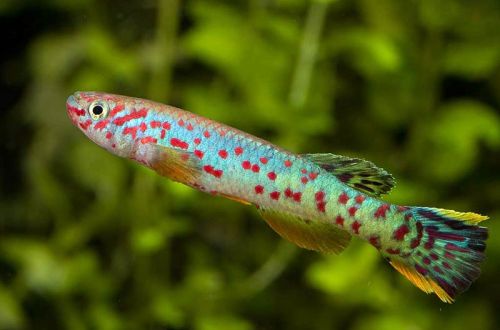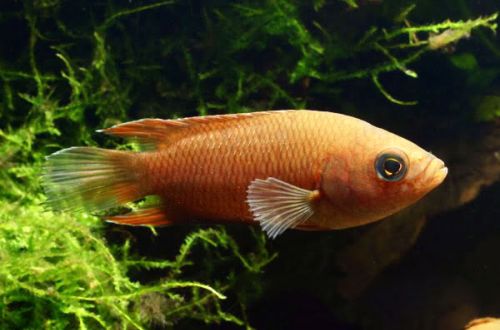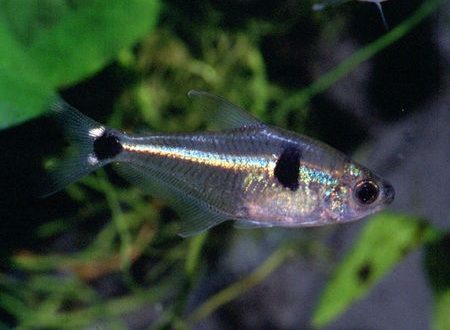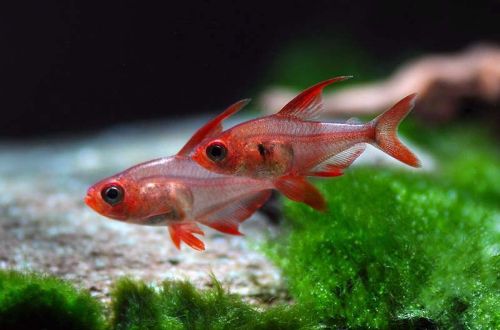
Aphiosemion Sheela
Afiosemion Scheela, scientific name Fundulopanchax scheeli, belongs to the Nothobranchiidae family. The fish is named after the Danish ichthyologist Jørgen Jacob Scheel (1916-1989). Previously, it belonged to the genus Aphyosemion, but since 2002 it has been transferred to Fundulopanchax, however, the former name has been preserved.

Contents
Habitat
The fish is native to Africa. The natural distribution area is limited to the border area in the southeast of Nigeria and northwest of Cameroon.
Inhabits small coastal streams, rivers and lakes in the depths of tropical forests.
Brief information:
- The volume of the aquarium – from 40 liters.
- Temperature – 23-26°C
- Value pH — 5.5–7.0
- Water hardness – soft (2-9 dGH)
- Substrate type – dark soft
- Lighting – subdued
- Brackish water – no
- Water movement – little or no
- The size of the fish is 5–6 cm.
- Meals – any rich in protein
- Temperament – peaceful
- Keeping a group in the ratio of one male and 3–4 females
Description
Adults reach a length of 5-6 cm. Males, unlike females, are larger and look more colorful, having a blue color with bright pink dots all over the body. The fins and tail are also brightly colored and have contrasting yellow edges. Females are somewhat smaller and more modestly colored.
Outwardly, it resembles another closely related species of Afiosemion Gardner, but differs in fewer pink speckles.
Food
The basis of the diet should be protein-rich foods, such as live or frozen insect larvae, bloodworms, brine shrimp and other small invertebrates. Can be accustomed to dry products in the form of flakes, granules.
Maintenance and care, arrangement of the aquarium
The optimal size of the aquarium for a group of 4-5 fish starts from 30-40 liters. The design uses a dark soft substrate and dense clusters of shade-loving plants, mosses and ferns, along with a few snags or any other objects that can act as shelters. The lighting is subdued. Additional shading will provide floating plants, which will also serve as a barrier for fish to jump out of the aquarium.
In the process of keeping Afiosemion Sheel, it is important to provide soft, slightly acidic water. Filtration should not be strong to avoid excess water movement. In small tanks, external filters or a simple airlift filter are recommended. Aquarium maintenance is standard: weekly replacement of part of the water with fresh water, regular removal of organic waste (food leftovers, excrement), equipment maintenance, etc.
Behavior and Compatibility
It is considered a calm peace-loving fish, meanwhile, males are not too friendly towards each other. In a small aquarium, the group size should be maintained in the ratio of one male and several females. As neighbors, you should choose miniature calm fish from among tetras, parsing, catfish corridors and others.
Breeding / breeding
Breeding is simple. Fish need to be provided with a balanced diet and suitable spawning sites in the form of clusters of small-leaved plants or mosses. The incubation period lasts about 14 days. It is advisable to transplant the fry into a separate tank with identical conditions. In the first days of life, fry need microfeed, such as ciliates or special suspensions. As they grow older, they will begin to take Artemia nauplii and other similar products. Grow fast. Sexual maturity is reached by 4-5 months.
Fish diseases
Suitable living conditions minimize the likelihood of a disease outbreak. The threat is the use of live food, which is often a carrier of parasites, but the immunity of healthy fish successfully resists them. Read more about symptoms and treatments in the Aquarium Fish Diseases section.





